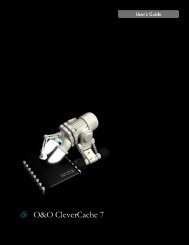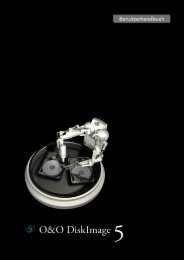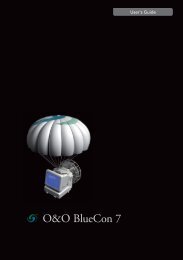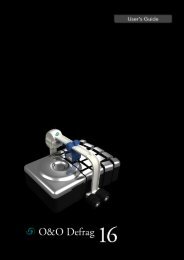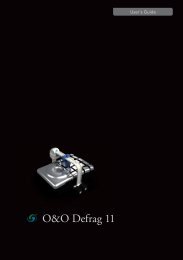O&O DiskImage 7 User's Guide - O&O Software
O&O DiskImage 7 User's Guide - O&O Software
O&O DiskImage 7 User's Guide - O&O Software
Create successful ePaper yourself
Turn your PDF publications into a flip-book with our unique Google optimized e-Paper software.
Scheduling functions<br />
Run after job is completed<br />
Here you can choose between Restart and Shut Down. If you don't select anything, the computer will return to its condition<br />
prior to imaging. It will usually just remain on.<br />
Characteristics of an imaging job<br />
Storage path<br />
The target path to the storage location of the image will be applied from the program settings by default. You may, however,<br />
select or enter a new path manually.<br />
Apply dynamically generated file names<br />
For a file name, the terms “Image” and the dynamically mounted parameters “year”, “month”, and “day”, will be used by<br />
default. In addition, you can select from a list of alternative parameters. If you’re making, for example, a number of<br />
images on a single day, it’s advisable to include the “time” in the file name. Otherwise, files with the same name would<br />
emerge and that could lead to the imaging process being aborted.<br />
Note: If you’re using O&O <strong>DiskImage</strong> on a computer in a network, the data from the computer will be automatically<br />
read and file names will be dynamically generated. You could, for example, add the “Computer Name” to the image<br />
name for use in a network.<br />
Create a job for incremental or differential imaging<br />
In order to create a differential or incremental imaging job, you'll need a complete or base image that was previously<br />
created. This complete image will serve as a base for creating differential/ incremental imaging jobs. The first image<br />
after the complete image is always a differential image. Incremental images can be based on a differential or other incremental<br />
images.<br />
1. Select Start drive imaging from the O&O <strong>DiskImage</strong> Start Page.<br />
2. Click top right on Imaging Options and activate Image of the changes then select the base image. Now close<br />
the options Window.<br />
3. Now click on Add as job.<br />
4. Enter the name and the schedule for the image in the job dialogue.<br />
5. Under Imaging you can either use the standard path or manually enter another storage location for the image.<br />
The option Use created image as base image for the following execution is enabled by default. Incremental<br />
images will always be created based on the last image of changes. As a result of this, the data volume of the incremental<br />
image will end up being very small. All previous cumulative images and the last complete image will be needed<br />
for restoration. We recommend saving the complete image as well as any successive image of the changes in one<br />
folder.<br />
If this is not possible, the default check has to be removed from Disable user inquires while task is running. The<br />
process is only partially automatic because every time an imaging is performed, all earlier images will be requested. If<br />
these are not entered, the job will be aborted as a result of error.<br />
The selection check for Use created image as base for the following execution is enabled by default. If you disable<br />
it, all further images will be created as differential ones using the last complete image for their base. Restoration will<br />
then require the last differential image along with the complete. Incremental images that were created in the meantime<br />
will no longer be needed. The data volume of these differential images is correspondingly larger than a series of incremental<br />
images.<br />
O&O <strong>DiskImage</strong>-58



